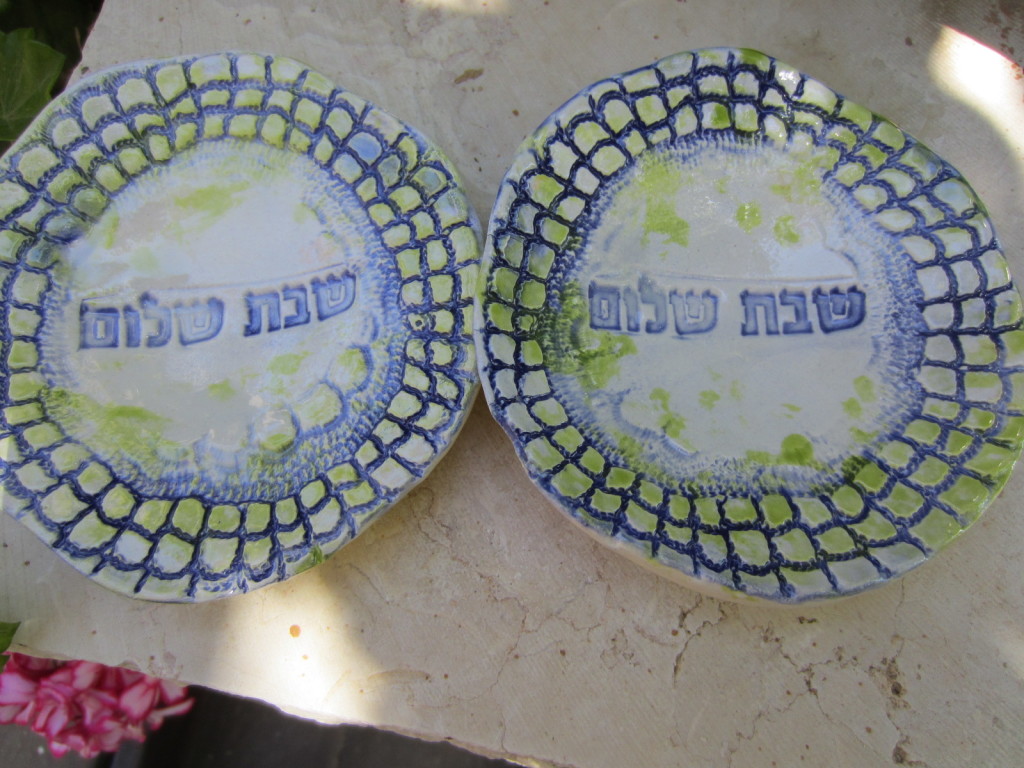THE SABBATH TABLE
First, thanks to all of those who wrote to me and shared their own stories of
 Jewish heirlooms. Remember, you don’t have to write to me personally: you can share your comments right on the Blog page at the bottom of each new Blog.
Jewish heirlooms. Remember, you don’t have to write to me personally: you can share your comments right on the Blog page at the bottom of each new Blog.
Second, thanks to those of you who have “entered” my “shoppe” and decided to purchase some of my “one-of-a-kind” creations. I am sure they will become the Jewish heirlooms of the future for your family, as well as special memories for the people to whom you have sent these items as a unique hand-made gift.
Third, and most important, this Blog series is all about precious family heirlooms which are not just ours to enjoy, but to treasure, protect, and pass on to future generations.
In a recent article by Rabbi Berel Wein (coincidentally called “The Shabbat Table”), Rabbi Wein says the following:
“One of the great joys of preparing for the Shabbat, at least as far as I am concerned, is preparing the Shabbat (Sabbath) table. The halacha provides for the necessity of preparing a Shabbat table, unique and glorified over all of the other tables of the rest of the week. A special tablecloth, usually white, is used, and today here in Israel there are embroidered and decorated cloths in honor of the Shabbat. Additionally, here and in many homes in the Diaspora as well, flowers are placed on the Shabbat table to enhance its beauty and allow us to appreciate the fantastic wonders of God’s natural world. The twin chalot, a remembrance of the double portion of manna that fell from heaven on Fridays in honor of the coming Shabbat, are placed on the table… A special challah cover is placed over the two loaves. Here also, as with the tablecloth, much room is left for the artistic expression of the Jewish heart. The variety of challah covers that exist today is almost infinite, as is the pleasure and beauty that each one of them brings to the Shabbat table. Usually a special bread board and bread knife, again reserved for Shabbat, also find their place on the table under the challah cover.
“The cup for kiddush is also placed on the table. This is usually silver and, again, is an individual expression of Judaic art… No matter what the case, kiddush cups are treasures, always viewed as heirlooms to be passed on to later generations. They would continue to be used to sanctify the Sabbath, the wine, the table and the family itself. There is nothing as precious in a Jewish home as a kiddush cup of a grandfather or great-grandfather. It is as though the family elder is still present at the Shabbat table, reveling in the joy of the successful transmission of Jewish tradition in his family.
“Napkin rings or other objects of beauty and good taste may enhance the
table. Here once again, the talented expressions of Judaic design and artistry are on display…The table reflects a royal splendor and holy beauty…The beauty of the Shabbat table, the emotional tug and the feeling of serenity that it generates is unmatched in Jewish life. The Jewish home that experiences the Shabbat and its glorious table, week after week, is truly blessed and rewarded.”
Thanks to Rabbi Wein for elaborating on my theme for this Blog:
THE SABBATH TABLE
I often quote from Rabbi Abraham Joshua Heschel z”l who stated in his book The Sabbath, “…the Sabbath is truly a “Palace in Time…” So why not adorn your table with those special items which bring respect to the Sabbath and at the same time create objets d’art and even curiosities for discussion. As Rabbi Wein says, even a simple thing as a napkin holder can be Jewish. See my ETSY site for some of my examples. Also Google “napkin holders” and you will see how my unique Jewish napkin holders can become the beginning of a love affair with these special table adornments. More on that in a future blog.
Whether you use your fanciest china, or a beautiful set of single use paper plates (which makes the clean up so much easier), you can still place some items of Jewish interest on your Sabbath table. My Mom z”l always reminded me that when you invite guests over for dinner, at any time of the week, you set a “proper” table, with flowers, special wine glasses and other adornments, so the table looks special and festive. So why not on the Sabbath?
My husband just reminded me of a game we used to play at the Sabbath table. We would pick up one item; it could be a napkin holder, a knife rest or even just a fork. Holding the item, each person, in turn, would have to come up with a novel (new) use for the item, then pass it on to the next person. You can only mention a purpose once. Keep going around the table until you get tired of the game. You’ll be surprised how much fun it can be. Creating memories at the Sabbath table. That’s what it is all about.
